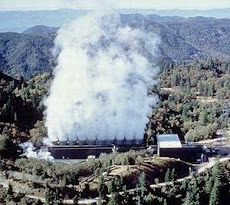"Borrowed" from the BLMs own website; You can click on the title above to go to the site and once there, page down to the "references / sources" citations at the bottom for some more interesting links, including one to "Bureau of Land Management," 1995. "Public Rewards from Public Lands." Available online at http://www.blm.gov/nhp/pubs/rewards/1995/covbkrwd.html.
-------------------------
During the period from Colonial times to the late 1800s, U.S. Government policy was essentially to dispose of all lands acquired by almost any means (e.g., the Louisiana Purchase of 1803) into private hands for settlement and development, to both create national wealth and secure sovereignty. There was an unquestioned belief that land and resources were to be improved and used, and that development would proceed most efficiently through private means.
The General Land Office (GLO) was created in 1812 to dispose of public domain lands in the mid-West and West. During the GLO's existence, over 1 billion acres of land were transferred from Federal to State and private ownership under Federal land laws, including the various homesteading and settlement laws and Statehood acts.
Numerous management authorities governing the use of the public lands and their resources accumulated from the early 1800s to the mid-1900s — in fact, there were thousands of them. These disparate authorities often resulted in fragmented, inefficient, and sometimes inconsistent resource management. These laws applied not only to grazing and land disposal, but also to mineral leasing and mining, timber harvesting, homesteading, and other subjects. The result was rapid economic development of the growing nation, but also some very obvious waste of resources.
By the 1870s, enough perceived problems had emerged with land disposition that the first moves toward public land retention were enacted by Congress. There was a growing sense that many lands, because of either their great public value (as in the case of the lands that would become Yellowstone National Park) or their remoteness and apparent lack of value, should be held in the public trust. This shift in attitude was based on the notion that there was a legitimate national interest in the remaining unsettled lands, and that this interest would be best served by Federal ownership. The reservation of Yellowstone National Park in 1872, and the 1891 General Land Reform Act that created the forest reserves, formally marked this change in public and Congressional thinking. The next four decades saw reservation (by various means, from Acts of Congress to Presidential Orders) from private ownership of essentially all of the Federal lands now in existence in the lower 48 states.
Another great change in thinking about public land management occurred after the turn of the century: the development of a progressive, scientific approach to resource "conservation" that emphasized sustained yield. Conservation, as it was defined by Gifford Pinchot, the first chief of the U.S. Forest Service, was the use of resources for the benefit of all in a manner that would not impair the resources' future productivity (in other words, "sustained yield"). The Taylor Grazing Act of 1934 can be viewed as an expression of this shift in attitude toward land retention and scientific conservation. On the conservation side, the Grazing Act clearly emerged from a sense that the western public domain had been degraded by grazing and drought, and needed a more regulated management framework. By the post-World War II period, however, many people (especially emerging environmentalists) were questioning the single-/dominant-use and commodity-oriented approach of Pinchot's resource conservation philosophy. The public wanted more care for other resources and "services" offered by the public lands, such as watershed, wildlife, and recreation.
The U.S. Department of the Interior's Grazing Service (originally known as the Grazing Division) was established in 1934 to administer grazing districts on suitable public rangelands. In 1946, in accordance with the Reorganization Act of 1945 and to assure greater use of and more efficient administration of Federal natural resources, the Grazing Service and the General Land Office were combined to form the Bureau of Land Management (BLM).
After many studies in the early 1960s, Congress established the bipartisan Public Land Law Review Commission in 1964 to make recommendations on how the public lands should be managed. The Commission's efforts culminated in the 1970 report to the President and Congress entitled One Third of the Nation's Land. After deliberations in three successive Congresses, the Federal Land Policy and Management Act was passed in 1976. Via this Act, Congress expressly declared as policy that the remaining public domain lands would be retained in Federal ownership unless disposal of a particular parcel served the national interest. FLPMA was designated as Public Law 94-579.
Retention of lands does not exclude private interests from actually developing and using the resources on public lands. The important role of private companies of all sorts, from timber companies to park concessionaires — who provide services and derive profit from public resources — continues today. FLPMA's formal declaration of a Federal retention policy was nevertheless a significant factor in the "Sagebrush Rebellion," a campaign by many westerners who still hoped that the substantial Federal presence might be reduced through Federal land transfers to private or State ownership. Begun in 1979 with the Nevada Assembly's passage of a bill calling for State control of BLM lands, the Sagebrush Rebellion had largely run its course by 1981.
The last large transfer of BLM land occurred in 1980 as a result of passage of the Alaska National Interest Lands Conservation Act (ANILCA), which shifted management responsibility for large tracts of land in Alaska from BLM to other land management agencies. BLM continues to transfer land to the State of Alaska and the Alaska Native Corporations under provisions of the Alaska Statehood and the Alaska Native Claims Settlement Acts.
FLPMA is called the BLM Organic Act because it consolidated and articulated BLM's management responsibilities. Many land and resource management authorities were established, amended, or repealed by FLPMA, including provisions on Federal land withdrawals, land acquisitions and exchanges, rights-of-way, advisory groups, range management, and the general organization and administration of BLM and the public lands. FLPMA also established BLM as a multiple-use agency — meaning that management would be accomplished on the basis of multiple use and sustained yield unless otherwise specified by law — and provided that:
. . . the national interest will be best realized if the public lands and their resources are periodically and systematically inventoried and their present and future use is projected through a land use planning process coordinated with other Federal and State planning efforts . . .
FLPMA also specified that the United States receive fair market value for the use of the public lands and their resources unless otherwise provided for by statute, and that:
. . . the public lands be managed in a manner that will protect the quality of scientific, scenic, historical, ecological, environmental, air and atmospheric, water resource, and archeological values; that, where appropriate, will preserve and protect certain public lands in their natural condition; that will provide food and habitat for fish and wildlife and domestic animals; and that will provide for outdoor recreation and human occupancy and use . . .
In short, FLPMA proclaimed multiple use, sustained yield, and environmental protection as the guiding principles for public land management. Thanks to FLPMA, BLM manages public lands so that they are utilized in the combination that will best meet the present and future needs of the American people for renewable and non-renewable natural resources.
--------------------------------------------------------------------------------
References:
Bureau of Land Management. 1995. Public Rewards from Public Lands. Available online at http://www.blm.gov/nhp/pubs/rewards/1995/covbkrwd.html.
Cody, B.A. 1995. "Major Federal Land Management Agencies: Management of Our Nation's Lands and Resources." Washington, DC: Congressional Research Service. Available online from the Congressional Research Service's National Library for the Environment at http://www.cnie.org/nle/nrgen-3.html.
Mitchell, J.G. 2001. "The Big Open: Going Public with the Public Lands." National Geographic. August 2001. pp. 2-29. Introductory portions of article and some captioned photos are available online at http://magma.nationalgeographic.com/ngm/data/2001/08/01/html/ft_20010801.1.html.
Muhn, J. and Stuart, H.R. 1988. Opportunity and Challenge: the Story of BLM. Washington, DC: Bureau of Land Management. 303 pp. Available from the BLM Printed Materials Distribution Section (PMDS) (website: http://ncweb.sc.blm.gov/pmds/; e-mail address: BLM_NCS_PMDS; ) as Item No. P-267. (This book has a good history of BLM, including some "I was there!" personal accounts by BLM-ers who helped make FLPMA happen.)
Travis, R. T. Undated. "Changing Federal Lands Management." in People and Rangeland Ecosystems (college course). University of Colorado, Boulder. Available online at http://www.colorado.edu/geography/projects/range/brief4_history.html.
U.S. Forest Service/Jorge Scientific Corporation, "USDI Bureau of Land Management: A Brief History." Undated. Available online at http://demo.jorge.com/fs/History_National/History_of_USDI-BLM.htm.
For FLPMA anniversary outreach tools and additional information:
A 1995 article entitled "Bureau of Land Management Authorization," by B.A. Cody and P. Baldwin, is available online from the Congressional Research Service's National Library for the Environment at http://www.cnie.org/nle/nrgen-7.html.
Copies of the original FLPMA (i.e., without subsequent amendments) are available from PMDS as Item No. P-139.
A summary of FLPMA's provisions and other information are available via the Library of Congress's legislative website at http://thomas.loc.gov/cgi-bin/bdquery/z?d094:SN00507:@@@L.
You can read the U.S. Code sections on FLPMA via the Cornell University Legal Information Institute website at http://www4.law.cornell.edu/uscode/43/ch35.html#PC35.
Copies of the Public Land Law Review Commission's 1970 report, One Third of the Nation's Land, are available from the National Archives and Records Administration, http://www.nara.gov/guide/rg409.html#409.3.
--------------------------------------------------------------------------------
http://www.blm.gov/flpma/organic.htm
Saturday, August 1, 2009
Subscribe to:
Post Comments (Atom)



















No comments:
Post a Comment